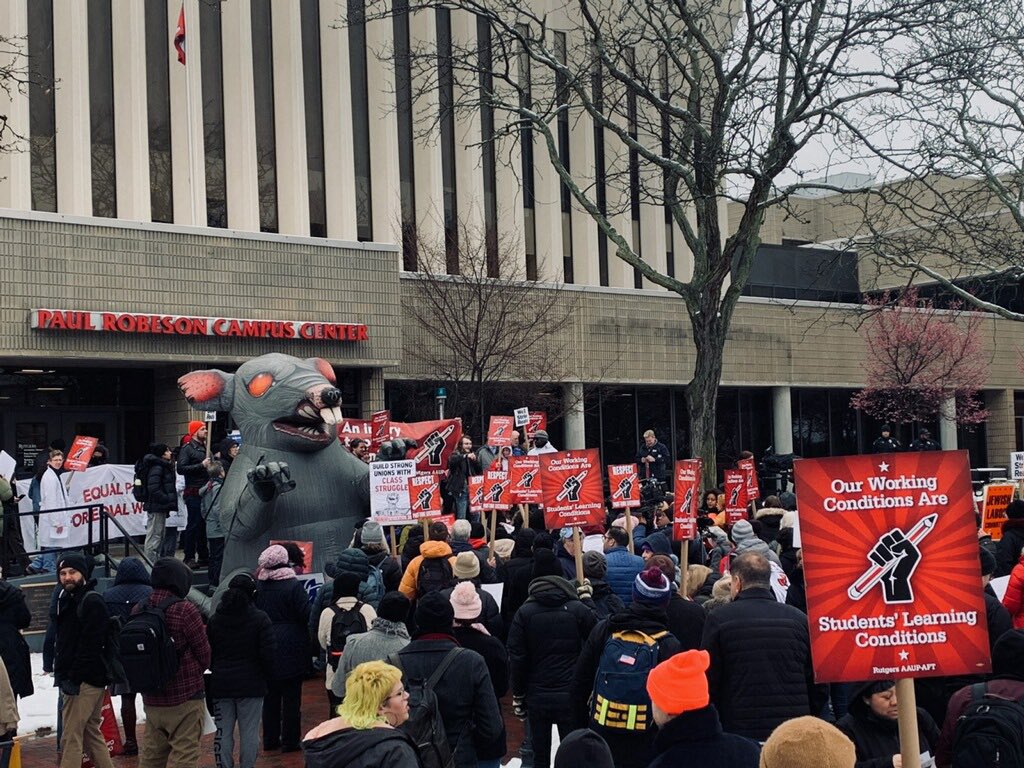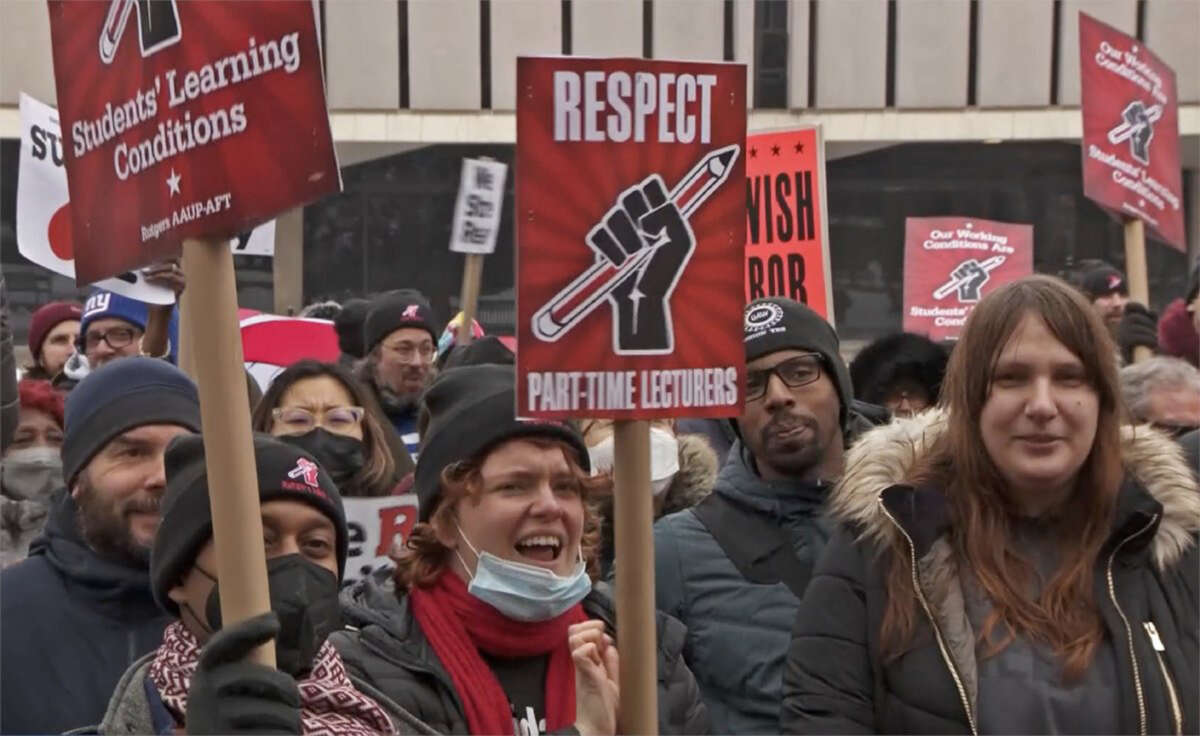In the past year, a wave of strikes has rocked universities from the University of California system on the West Coast to Temple University in Philadelphia and The New School in New York City. In all, there were 15 strikes by academic workers in 2022, and this trend has continued into 2023. In several cases, it is precarious workers such as adjunct faculty and graduate students who have been on the front lines and who have struck with the support of full-time faculty.
Here at Rutgers, where I work as a professor, full-time and adjunct faculty, graduate workers and postdoctoral associates are all poised to strike together for the first time in our history.
We almost went on strike in 2019, when I was president of the Rutgers American Association of University Professors and American Federation of Teachers (AAUP-AFT). The strike was averted because just the threat of a strike, in the midst of a wave of K-12 teachers’ strikes the previous year, led to a historic contract settlement. However, our adjunct faculty union wasn’t strike-ready and made only modest gains.
This time, the Rutgers AAUP-AFT and the Rutgers Adjunct Faculty Union jointly began a strike vote on February 28. The vote ends on March 10 and should contracts not be settled, both unions will likely call a strike shortly after. If that occurs, it will be the first strike at Rutgers in its 250-plus-year history.
Why are academic workers striking? Simply put, they are fed up with the priorities of the corporate university that put profit ahead of the academic mission of research, teaching and service. And strikes are proving to be the key vehicle through which faculty and students can push back against the corporate model and create the kind of university we deserve.
Public universities and land-grant universities were meant to serve the public and provide education to those who couldn’t afford private university tuitions. However, over the last few decades, public higher education has moved away from its mission of serving the common good and has become a source of profit generation. Profits have been made in a variety of ways, including raising the cost of tuition, which saddles students with mountains of debt. Universities have cut costs by replacing secure tenure-track jobs with part-time faculty who are paid a pittance and often lack basic benefits like quality health insurance. This has an impact not only on part-time faculty but on students and their overall educational experience.
“Imagine working at a university for 5 or 10 or 15 years or longer and having to reapply for your job every term,” says Bird Jackson, a part-time lecturer (PTL) at Rutgers-Newark. “That’s the situation of PTLs at Rutgers. We are overloaded with unpaid work that follows us home. Grading, lesson planning, syllabus development, office hours, campus commute, and unguaranteed parking all cost adjuncts either energy or income. We can’t plan our lives for any length of time, nor assure students that we will be available to mentor and assist them. Our working conditions are our students’ learning conditions.”

In the neoliberal era, the university has followed the same trends as corporations in moving toward a reliance on part-time workers. Thus, over the last few decades, secure tenured and tenure-track faculty positions have been replaced by non-tenure-track and part-time faculty.
Over the last decade at Rutgers, intensive rank-and-file organizing translated into significant gains for our non-tenure-track faculty, who are part of the Rutgers AAUP-AFT along with tenured and tenured-track faculty. They won a decent base salary, a promotion process with corresponding salary increases, long-term contracts of up to seven years, and a robust grievance process. Now we are fighting for tenure to become accessible to non-tenure-track teaching faculty. However, part-time lecturers, who do virtually the same work as non-tenure-track faculty, have fallen behind. This is why they are fighting for equal pay for equal work; they want “fractional appointments” that pay them at the same rate per credit hour taught as received by non-tenure-track faculty.
This demand was put on the table during contract negotiations in 2018–19. However, the part-time lecturers’ union (separate from the larger union representing full-time faculty and grads) did not prioritize organizing and was therefore not strike-ready to win this demand. Recognizing the mistakes made in previous years, a new adjunct union leadership has emerged that has taken a more activist approach.
“Several of us who hold positions on the executive board of the part-time lecturers’ union first ran for office because we were dissatisfied with the approach our past leadership took during the previous contract campaign,” said Bryan Sacks, a part-time lecturer and vice president of the Rutgers Adjunct Faculty Union. “In our view, the reason for these failures was that leadership did not practice true democratic unionism, and thus it failed to build the requisite strength for achieving transformational change through the mass organizing of rank-and-file PTLs behind these demands.” Additionally, Sacks said, the union’s leadership did not sufficiently understand the value of building a strong relationship with the leaders of the full-time faculty/grad worker unit, nor the value of close coordination with them. “These shortcomings significantly hampered our unit’s ability to meaningfully participate in the full-time unit’s successful contract campaign, which featured the securing of a strike authorization vote just before they won truly historic contractual gains.”
These historic gains didn’t happen by chance. After the financial crisis of 2007-2008, our subsequent contract was weak and consisted of wage freezes. The leadership at that point understood that the old service union model was not working; they invited some of us with a more radical social justice and rank-and-file vision to take the lead. The 2014 contract was a big improvement over the previous one because we organized a contract campaign. These organizing efforts continued during the Trump era when we mobilized against the Muslim ban and the attacks on DACA. Such an intersectional approach that centered gender, race and social justice demands (in addition to bread-and-butter class-based issues) made the union attractive to scores of our members who gravitated toward activism in the union. This is what allowed us to get strike ready and to win significant concessions from management in 2019.
Over 90 percent of members voted to go on strike for a number of issues, including the principle of equal pay for equal work for women faculty and faculty of color, job security for non-tenure-track faculty, and substantial wage increases for graduate workers. While we won $20 million to hire historically under-represented faculty, a new pay equity process that addresses salary inequity, including by campus, and gains for our non-tenure-track faculty, the part-time lecturers’ union only made modest gains for the reasons that Sacks outlined.
This time, however, all faculty are working together as one big union. The new leadership we recruited to replace us after 2019 have built on our past successes. They are calling on the administration to recognize a single bargaining unit that negotiates for full-time faculty, adjunct faculty, and our colleagues in medical schools that were absorbed into the Rutgers system a decade ago. Additionally, they have deepened relationships with all the unions at Rutgers, including those representing blue-collar workers, in a model of industrial unionism that eschews divisions, hierarchies and snobbery based on job title, rank and category. Intensive organizing work done during the pandemic created a sense of unity in which people who work for Rutgers, in whatever capacity, came to see that we are all in this together and dependent on one another. Our unions came together to offer work-sharing in place of Rutgers’ plans for mass layoffs. This too was a historic first.
Yet, here we are again eight months past the expiration of our contract with little headway at the bargaining table. This is a standard delay technique designed to create demoralization. But we know better. One of the lessons from the almost-strike in 2019 was that we have power when we come together. We had overwhelming student support because our students saw that our working conditions were their learning conditions; we also had public support. Struggle is contagious, and our past victories as well as those of our colleagues at other universities have only raised our expectations. This is why we at Rutgers may be the next to go on strike to win the university that we all — faculty, staff and students — deserve.
Our most important fundraising appeal of the year
December is the most critical time of year for Truthout, because our nonprofit news is funded almost entirely by individual donations from readers like you. So before you navigate away, we ask that you take just a second to support Truthout with a tax-deductible donation.
This year is a little different. We are up against a far-reaching, wide-scale attack on press freedom coming from the Trump administration. 2025 was a year of frightening censorship, news industry corporate consolidation, and worsening financial conditions for progressive nonprofits across the board.
We can only resist Trump’s agenda by cultivating a strong base of support. The right-wing mediasphere is funded comfortably by billionaire owners and venture capitalist philanthropists. At Truthout, we have you.
We’ve set an ambitious target for our year-end campaign — a goal of $250,000 to keep up our fight against authoritarianism in 2026. Please take a meaningful action in this fight: make a one-time or monthly donation to Truthout before December 31. If you have the means, please dig deep.
